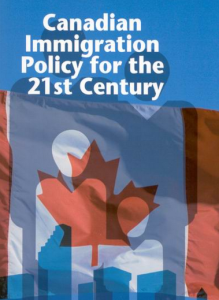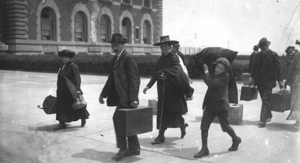In a previous blog post, we discussed the fear of deportation and how Mexican citizenship is on the rise as families fear separation due to the government reinforcing immigration laws.
In the United States and Canada, sanctuary cities are determined to reduce fear of deportation through limited cooperation with the national government and its immigration laws. By making the undocumented immigrants feel safe, it gives them more opportunity to report crime, enroll their children in school and opt for health and social services.
The sanctuary policies that more and more cities are adapting prohibit government and city employees from asking an immigrant about their status in the United States. It brings the question to rise if whether or not it’s constitutional for local police and government to enforce immigration laws.
Back in January of 2017, President Donald Trump declared that sanctuary cities would be punished through federal funding being withheld from any city with sanctuary policies. However, a judge in San Francisco blocked that plan stating Trump had exceeded his presidential authority. This judge was not the only one to believe that withholding funding unless a city complies with federal immigration enforcement and laws, believing this is unconstitutional and the President doesn’t have the right to sign such regulations.
There is major debate between sanctuary cities and the rest of the government. Washington made a statement declaring that sanctuary cities put the protection of illegal immigrants above the safety of their citizens. Sanctuary cities prevent their local police and government from sharing criminal immigrants with federal authorities, meaning an illegal immigrant that breaks the law and serves in jail has almost zero risk of deportation inside a sanctuary city.
Many outside of the sanctuary city policies think that even if these cities mean well for illegal immigrants that mean no harm, it places too much protection on the immigrants who are criminals, involved with human trafficking, drugs and the death of abiding American citizens.
Texas Governor, Greg Abbott, supports the restrictions to sanctuary cities and withholding funding for not complying with federal immigration laws. Abbott brings a great point to the forefront of this debate: federal, state or local government all have one primary function – to keep our people safe.
So are sanctuary cities safe? Stay tuned as this debate continues.


 The new immigration policy of the 1920s, the Great Depression, and World War II caused there to be a dramatic decrease in immigration to Canada and the United States. After World War II, legislation allowed refugees and displaced persons from the war to immigrate to the United States and Canada. Both countries’ ideologies began to shift more towards egalitarian ideas such as welfare state and multiculturalism which implemented more tolerance towards people of different races and lead the charge against racial discrimination.[1] During the 1960s, the Civil Rights Movement lead to an increasing interest group for racial acceptance which fostered the new immigration policies implemented by the United States and Canada. (Talk about Great Society coalition of Jews, Catholics and Liberals as described in Mills) It was with these policies in which Canada decided to take a different route than that of the United States’.
The new immigration policy of the 1920s, the Great Depression, and World War II caused there to be a dramatic decrease in immigration to Canada and the United States. After World War II, legislation allowed refugees and displaced persons from the war to immigrate to the United States and Canada. Both countries’ ideologies began to shift more towards egalitarian ideas such as welfare state and multiculturalism which implemented more tolerance towards people of different races and lead the charge against racial discrimination.[1] During the 1960s, the Civil Rights Movement lead to an increasing interest group for racial acceptance which fostered the new immigration policies implemented by the United States and Canada. (Talk about Great Society coalition of Jews, Catholics and Liberals as described in Mills) It was with these policies in which Canada decided to take a different route than that of the United States’. Immigration policy rose in national importance in the 1920s for a couple of reasons. “Economic concerns, nationalism brought about by World War I, and a tilt toward a smaller percentage of new immigrants with English as their native language contributed to moving public sentiment towards restricting immigration”. The emergence of “Eugenics” as a public policy tool in policy circles and Western philosophy also played a role. “Eugenics is the belief in improving the qualities of the human race by preventing the reproduction of people deemed to have genetic defects or undesirable characteristics and/or encouraging increased reproduction by those with supposed desirable inheritable characteristics.” According to Anderson, this widespread belief in eugenics was a decisive factor in creating the restrictive immigration laws in the 1920s. Natives in Canada and the United States were in favor of the status quo of their countries, so they did not want a large amount of immigrants they deemed as “undesirable” tainting their countries national structure.
Immigration policy rose in national importance in the 1920s for a couple of reasons. “Economic concerns, nationalism brought about by World War I, and a tilt toward a smaller percentage of new immigrants with English as their native language contributed to moving public sentiment towards restricting immigration”. The emergence of “Eugenics” as a public policy tool in policy circles and Western philosophy also played a role. “Eugenics is the belief in improving the qualities of the human race by preventing the reproduction of people deemed to have genetic defects or undesirable characteristics and/or encouraging increased reproduction by those with supposed desirable inheritable characteristics.” According to Anderson, this widespread belief in eugenics was a decisive factor in creating the restrictive immigration laws in the 1920s. Natives in Canada and the United States were in favor of the status quo of their countries, so they did not want a large amount of immigrants they deemed as “undesirable” tainting their countries national structure. After the Second World War, Canadian immigration policy became a little less race oriented and geared more toward economic profitability. Finally in 1962, Ellen Fairclough, Minister of Citizenship and Immigration basically eliminated racial discrimination by implementing a new Canadian immigration policy. This new immigration policy stated that if an immigrant wanted to come to Canada and was not sponsored, as long as that immigrant proved his educational skill or quality that seemed desirable for Canada, he or she was allowed to immigrate without racial bias. Whereas the United States took a more humanitarian approach to immigration policy reform in the 1960s, Canada’s immigration reform was geared more towards the economic needs of Canada, as evidenced by its point based system.
After the Second World War, Canadian immigration policy became a little less race oriented and geared more toward economic profitability. Finally in 1962, Ellen Fairclough, Minister of Citizenship and Immigration basically eliminated racial discrimination by implementing a new Canadian immigration policy. This new immigration policy stated that if an immigrant wanted to come to Canada and was not sponsored, as long as that immigrant proved his educational skill or quality that seemed desirable for Canada, he or she was allowed to immigrate without racial bias. Whereas the United States took a more humanitarian approach to immigration policy reform in the 1960s, Canada’s immigration reform was geared more towards the economic needs of Canada, as evidenced by its point based system.
 Opposition towards immigration began in the late 19th century as the immigrants coming into the United States (Irish Catholics, Germans, Chinese, Spanish) were ethnically different than the immigrants who had already established themselves (English Protestants). Eventually the opposition became strong enough to create political pressures that called for immigration restrictions during the early 20th century.
Opposition towards immigration began in the late 19th century as the immigrants coming into the United States (Irish Catholics, Germans, Chinese, Spanish) were ethnically different than the immigrants who had already established themselves (English Protestants). Eventually the opposition became strong enough to create political pressures that called for immigration restrictions during the early 20th century. Immigrating to the United States of America is not made easy by all of the laws an bureaucracies put in place. Many people in the United States are against amnesty and other forms of citizenship that allow illegal immigrants to stay in the United States. Their rational being that if the illegal immigrants want to stay in the United States, they should apply for a visa and wait until they are legally approved. This makes sense at first glance, but within the constructs of the law is an extremely untimely bureaucratic process that gives immigrants little hope of living legally in the United States anytime soon.
Immigrating to the United States of America is not made easy by all of the laws an bureaucracies put in place. Many people in the United States are against amnesty and other forms of citizenship that allow illegal immigrants to stay in the United States. Their rational being that if the illegal immigrants want to stay in the United States, they should apply for a visa and wait until they are legally approved. This makes sense at first glance, but within the constructs of the law is an extremely untimely bureaucratic process that gives immigrants little hope of living legally in the United States anytime soon.